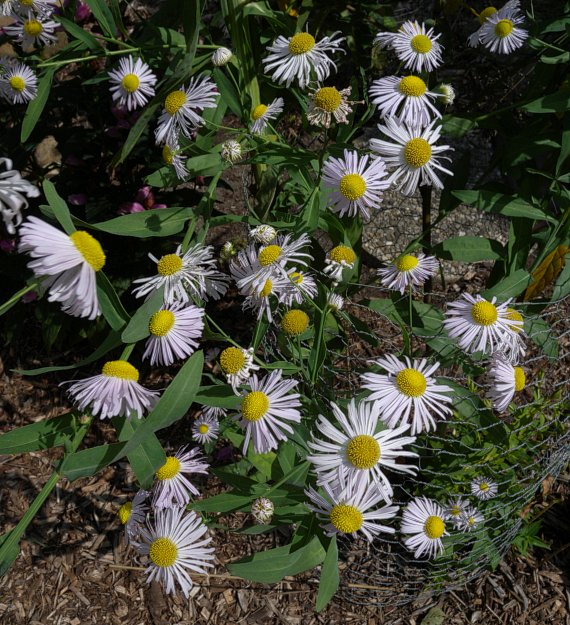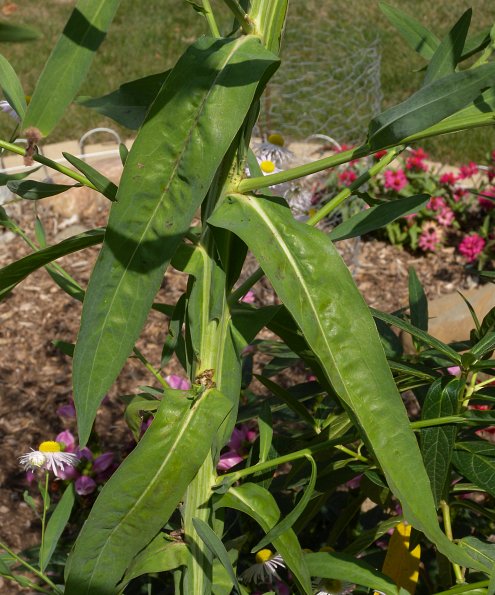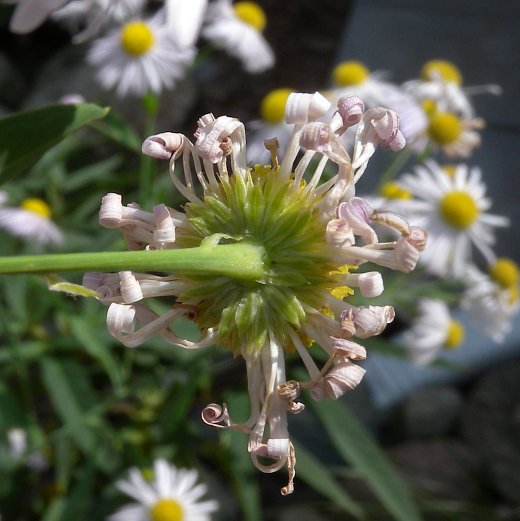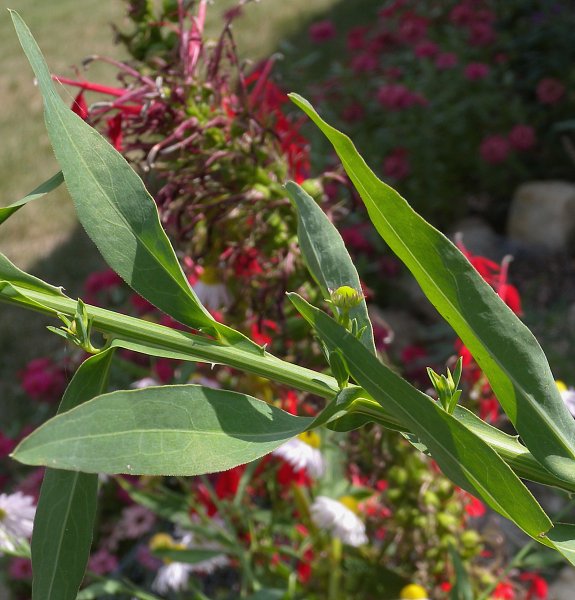
The central stems terminate in large panicles of flowerheads (up to 2' long and 2' across) that are more or less dome-shaped. On robust plants, many lateral stems will also terminate in smaller panicles of flowerheads. The branches of these inflorescences are similar to the stems, except they are less winged from the decurrent bases of their leafy bracts. These bracts are up 3" long and ½" across and they are similar in appearance to the leaves of lateral stems, although they can become smaller in size. Each daisy-like flowerhead is ¾–1" across, consisting of 40-60 ray florets that surround a dense head of 180+ disk florets. The ray florets are pistillate (female), while the disk florets are perfect (male and female). The petaloid rays of these flowerheads are linear-oblong in shape and white (rarely lavender or light purple). The corollas of the disk florets are about 2 mm. long, yellow, tubular in shape, and 5-lobed along their upper rims. Around the base of each flowerhead, light green phyllaries (floral scales) are arranged in about 3 overlapping series. These phyllaries are linear-oblanceolate in shape, membranous along their margins, and appressed together. When the flowerhead blooms, these phyllaries form an involucre that is shaped like a shallow plate or flat disk. The peduncles (basal stalks) of these flowerheads are up to 3" long. The blooming period occurs during late summer into autumn, lasting about 1-2 months. Afterwards, the fertile florets are replaced by achenes about 1.5–2.5 mm. in length. These achenes are obovoid, somewhat flattened, and slightly winged along their margins; solitary pairs of awn-like scales occur at their apices. The achenes can be blown about by the wind or float on water. The root system is shallow and fibrous.

Cultivation: The preference is full sun, wet to moist conditions, and fertile soil containing loam, clay-loam, or silty deposits. However, this plant can adapt to drier conditions in gardens if it is watered during dry spells. Growth and development from seed is usually rapid, as this plant can bloom during the first year. Some stakes or a wire cage may be necessary to keep it upright in a flower garden or rain garden.
Range & Habitat: The Decurrent False Aster is largely restricted to several counties in central and SW Illinois, where it is found along the floodplain of the Illinois River (see Distribution Map). This species has also been found at Lake County in NE Illinois, where it is adventive. Outside of Illinois, a few small colonies of plants have been found along the floodplain of the Mississippi River in eastern Missouri. Decurrent False Aster is a rare plant that is listed as 'threatened' in Illinois, and it is also listed as 'threatened' at the Federal level of the United States. Populations of this plant can vary considerably from year-to-year depending on the pattern of precipitation and flooding along the Illinois River and Mississippi River. Flood-control projects, wetland habitat destruction, and excessive sediment in the water during floods can undermine the long-term survival of this plant. Habitats include riverbottom prairies, shallow marshes, and mud flats along major rivers. This is a conservative species that is found in wetland habitats along rivers that are prone to occasional flooding. Such floods reduce competition from other herbaceous plants and woody vegetation.

Faunal Associations: Very little is known about the floral-faunal relationships of Decurrent False Aster (Boltonia decurrens), although it is probably similar to the more common False Aster (Boltonia asteroides). Pollinators of the flowerheads probably consist of long-tongued bees, short-tongued bees, wasps, flies, butterflies, skippers, and beetles. Both nectar and pollen are available as floral rewards. One bee species, Perdita boltoniae, is a specialist pollinator (oligolege) of Boltonia spp., and another bee, Melissodes boltoniae, may be a weak oligolege of these plants (Robertson, 1929). The larvae of a beetle, Microrhopala xerene, mine the leaves of False Aster and other species in the Aster family (Clark et al, 2004). The relationship of Decurrent False Aster to vertebrate animals is probably similar to many wetland asters (Aster spp.).
Photographic Location: A flower garden in Champaign, Illinois.

Comments: This rare wildflower adapts to gardens readily and it should be cultivated more often. Decurrent False Aster (Boltonia decurrens) is similar in appearance to False Aster (Boltonia asteroides), except the latter species lacks decurrent wings along its stems. Decurrent False Aster also lacks the wandering rhizomes of the latter species, although it is capable of developing more than one shoot from its root system. Decurrent False Aster is sometimes classified as a variety of this latter species, or Boltonia asteroides decurrens. False asters (Boltonia spp.) differ from asters (Aster spp., Symphyotrichum spp., etc.) by lacking tufts of hair on the apices of their achenes. Instead, the achenes of false asters have awn-like scales in pairs. In addition, the bases of their flowerheads (involucres) are more flattened in appearance (shaped like a shallow dish or flat disk), while those of asters are more cup-like or turban-shaped (turbinate). The flowerheads of False Asters resemble those of fleabanes (Erigeron spp.), except the flowerheads of the latter bloom earlier in the year and their achenes have sessile tufts of bristly hairs.